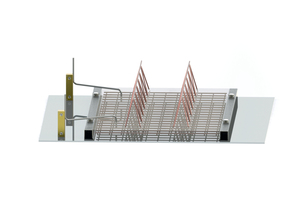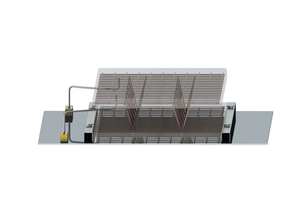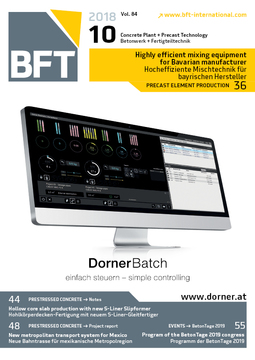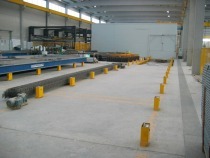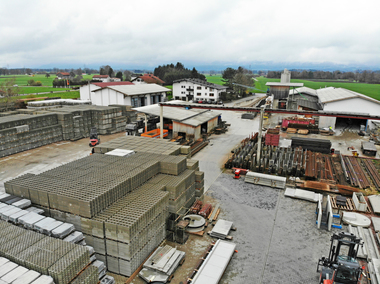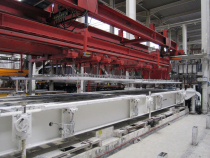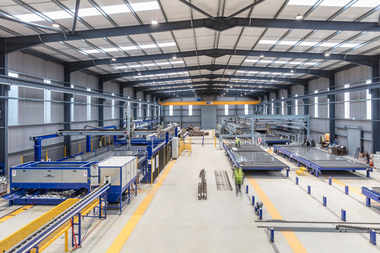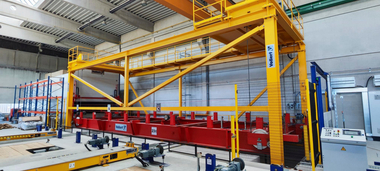Manufacturing double walls without shell offset
The manufacture of double walls in pallet circulation systems is a well-established and highly efficient production process. However, production-related faults often occur in this process. This problem is solved by a new product.
Double walls are manufactured in a multi-stage process. After being cast and hardened, the first shell is turned with the aid of a turning unit and positioned into the fresh concrete of the second shell. The concrete is compacted at the same time. In this production process, however, misalignments may occur between the first shell and the second shell. If such misalignment is observed in the production process, it has to be adjusted manually. The productivity is reduced by the downtime in the manufacturing process.
Useful for walls with shafts and pins
Frequently, problems also occur in the next process stage, with requiring time-consuming correction or even making a correction impossible. Because, while hardening, the first shell weighting up to several tons is normally placed on a couple of spacers. Due to the mass inertia of the first shell, abrupt starting or sudden braking of pallets in a pallet circulation system may result in a relative misalignment of the first shell to the second shell, while the first shell is placed in the fresh concrete of the second shell. In this case, the lower pallet starts and the first shell resting on the same remains in position for a short moment before it also begins to move. This is an undeniable problem occurring with all kinds of connectors such as lattice girders, GFRP tie anchors as well as shafts. Moreover, the pallets are often slowed down by bumping into a buffer in the curing chamber. Should the panels shift against each other in such a case, a correction is no longer possible at all.
Even if an offset of the concrete shells is only minimal per meter of joint, the joint pattern of a double wall that is several meters high can be misaligned by many millimeters. Consequently, this results in cost-intensive customer complaints or even very elaborate sawing for adjusting the walls on the construction site. An interruption in the installation of the walls delays the construction process.
Easy and efficient installation
Double walls without shell offset can be achieved by the so-called „SchwaBi“ element, conceived by Josef Binsteiner at the Schwarzenbeck precast concrete plant and exclusively sold by B.T. Innovation GmbH.
The installation of the system that is filed for patent is easy and efficient. Two steel stirrups (in short: SB) per wall element are positioned by means of magnet carriers (in short: SBH), featuring a guiding rail and a bore hole, and are embedded in concrete in a slightly inclined position in relation to the outer edge of the concrete. Afterwards the SBH magnet carrier is removed and simply plugged on the rod. The second shell is cast and turned into the first shell. In this process, the magnet adheres to the stirrup, gets in contact with the steel table when lowering and fixes the first shell in its position. Two „SchwaBi“ elements are adequate for a wall thickness of up to 30 cm, four stabilizing elements are required from a wall thickness of 40 cm. The geometries of the first and second shell, e.g., in case of dimension offset, have to be considered, when positioning the „SchwaBi“ elements, so that the magnet reliably gets to the shuttering table, when turning the first shell, and not to the concrete of the second shell or the shuttering board.
Strongly increased productivity thanks to „SchwaBi“
A displacement of the concrete elements during compaction and when moving the pallets is prevented and precisely fitting precast concrete elements leave the curing chamber.
The steel stirrups are cut through afterwards and the walls are installed on the construction site. The steel stub remaining on the inner surface of the first shell is embedded in concrete, thus not being a point of corrosion attack.
The Schwarzenbeck precast concrete plant strongly increased the productivity thanks to the „SchwaBi“ element. The double walls will no longer have to be adjusted after turning. As a result, several minutes per pallet are saved in the circulation and production failures are virtually excluded. Complaints are reduced and a smooth construction process can be ensured.

